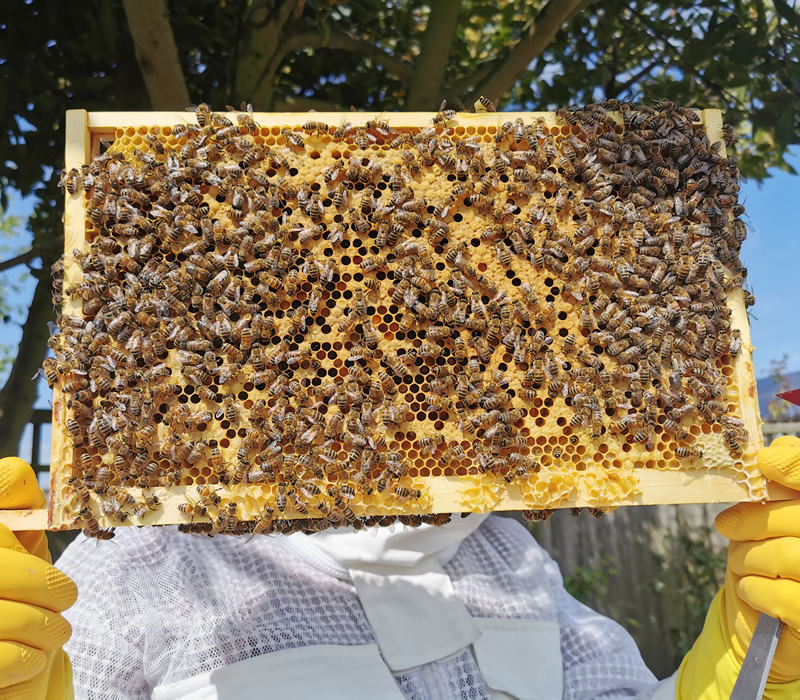Blog
Catch up on the latest from Bacton Bees, including sponsor news, photos and hive updates.
The Beekeeping Journey
27 July 2025
Beekeeping with Louise & Ian.
🐝 Welcome to the Buzzing World of Beekeeping!
There’s something truly magical about opening a hive and witnessing the delicate rhythm of thousands of bees working in harmony. Beekeeping, or apiculture, isn’t just a hobby—it’s a rewarding way to support the environment, produce your own honey, and connect with nature on a whole new level.
Whether you're drawn in by curiosity, sustainability, or a deep love of pollinators, starting out doesn’t require acres of land or a lifetime of expertise. With a bit of guidance and a dash of patience, anyone can become a beekeeper.
In this blog, we’ll walk through:
-
🌼 The basics of setting up your first hive
-
🧑🌾 Equipment you’ll need (and what you can skip for now)
-
🍯 How bees create honey—and how you’ll harvest it
-
🚫 Common mistakes new beekeepers make and how to avoid them
Get ready for sticky fingers, soothing hums, and the joy of watching your hive grow and thrive. Your journey into beekeeping starts here—and I’ll make sure it’s sweeter than honey. 🍯✨

🐝 January
- Monitor hive health: Check for signs of dampness, mold, or dead bees. Ensure ventilation is adequate.
- Check for stores: Bees need food to survive winter. If stores are low, consider feeding fondant or candy.
- Inspect for pests: Look for signs of varroa mites or other pests. Treat if necessary.
- Review records: Go over last season’s notes to plan improvements.
- Order supplies: Purchase frames, foundation, hive parts, and protective gear.
🐝 February
- Continue feeding if needed: Bees may still need fondant or candy.
- Plan for new colonies: If you're expanding, order new bees (nucs or packages).
- Clean equipment: Sterilize tools, smokers, and feeders.
- Check hive entrances: Make sure they’re clear of snow or debris.
- Attend courses or talks: Great time for learning and networking with other beekeepers.
🐝 March
- First inspections (weather permitting): On a warm, calm day (>10°C), do a quick check to assess colony strength.
- Feed syrup if needed: Switch from fondant to light syrup as brood rearing begins.
- Prepare for splits or queen rearing: Get equipment ready if you plan to split colonies.
- Set up bait hives: If you’re catching swarms, get them ready.
- Final equipment checks: Make sure everything is ready for April’s busy season.
Some helpful tips to start from when you begin opening the hive again.
🐝 1. Choose the Right Day
- Temperature: Aim for a sunny, calm day with temperatures above 10°C (50°F).
- Time of Day: Midday is best when bees are more likely to be flying and less defensive.
🐝 2. Keep It Brief
- Don’t spend too long with the hive open—just enough to check essentials.
- Avoid removing too many frames or disturbing the cluster.
🐝 3. What to Check
- Queen presence: Look for eggs or larvae as signs she’s active.
- Brood pattern: Should be compact and healthy-looking.
- Stores: Ensure there’s enough honey or feed to last until nectar flow.
- Colony strength: Count frames covered in bees.
- Cleanliness: Check for mold, damp, or dead bees.
- Pests: Look for varroa mites, wax moth, or signs of disease.
🐝 4. Be Prepared
- Have spare frames, feed, and cleaning tools ready.
- Bring record sheets or a phone to note what you see.
🐝 5. Feed If Needed
- If stores are low and weather is warming, consider feeding light syrup (1:1 sugar to water).
🐝 6. Stay Calm and Gentle
- Move slowly and deliberately.
- Use smoke sparingly—just enough to calm the bees.
Bees in the garden waste bin
17th August 2025
Bees found in compost bin.
🐝 Blog Update – Week of 10th August 2025
Unexpected Guests in the Compost Bin
This week, we were called out to a rather unusual situation—a hive of bees had taken up residence in someone’s compost bin!
The homeowner had noticed increased bee activity and, upon lifting the lid, discovered a thriving colony nestled among the organic waste. While compost bins aren’t a typical choice for bees, they can offer warmth, shelter, and a surprising amount of protection from the elements.
We carefully assessed the situation and safely relocated the colony to a proper hive. The bees were calm and healthy, and we’re happy to report they’re now settling into their new home where they’ll be much easier to manage and monitor.
🧰 What We Learned:
- Bees can be incredibly resourceful when it comes to finding shelter.
- Always check unusual places if you notice unexpected bee activity.
- Early intervention helps ensure the safety of both bees and people.
If you ever spot bees in an odd location, don’t panic—reach out to your local beekeeping group or pest control with bee-friendly practices.